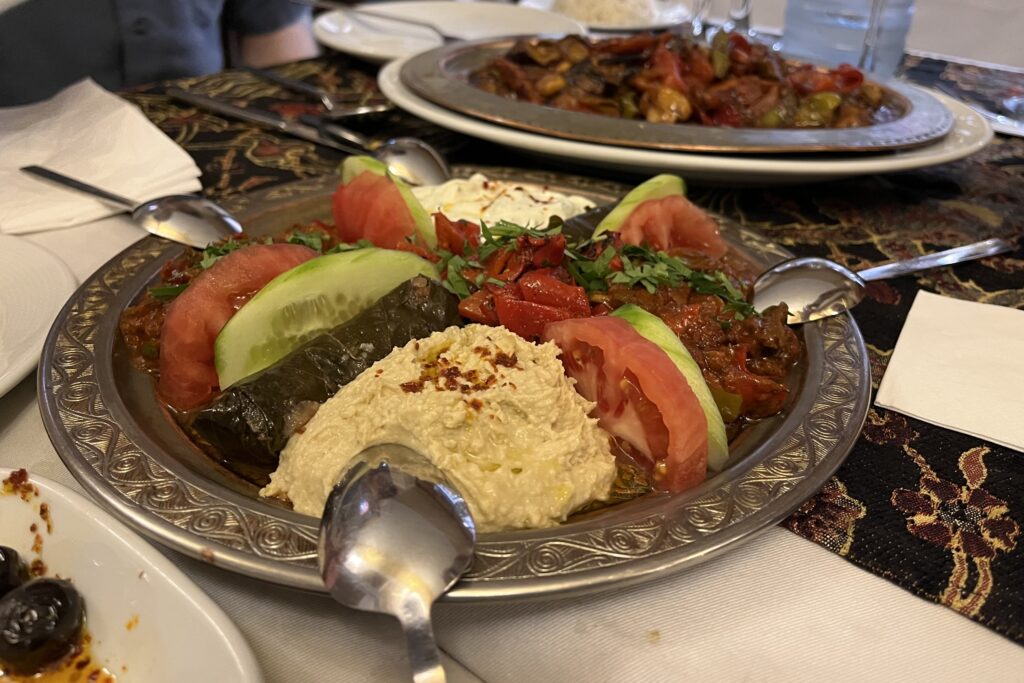Each morning in Turkey I looked forward to the hotel breakfast. That may seem incredible if you have only had American motel breakfasts. In the US the breakfast buffet includes foods such as tasteless bagels, breads seemingly sourced only for their shelf life, yogurt and cereals heavily laden with sugar, and steam tables with rubbery eggs and soggy potatoes.
In Turkey breakfast is a feast. Surprisingly, it leans heavily on salad. Sometimes hotels would set out a large buffet, and sometimes wait staff delivered an array of small dishes that filled the entire table. Every breakfast included arugula and parsley that looked and tasted like they had been picked that day, along with sliced tomatoes and cucumbers. Often we would also have other assorted salad greens and other fresh herbs, such as mint and dill.
Breakfast would also include at least two types of olives. There were always kalamata olives and sometimes savory grilled green olives that I had never tasted before. (I have since found grilled green olives at Trader Joe’s; who knew?) We would also find two or three different cheeses, such as a creamy feta or other goat cheese, along with a variety of breads. Simit, a round bread that resembled a sesame bagel, was common. (Simit is also available from street vendors in large cities.) One hotel’s breakfast included a different small savory pastry every day, filled with ingredients like spinach or a soft white cheese—as well as dessert!
Breakfast options always included hard-boiled eggs and sometimes eggs cooked to order. There was an array of sauces, including different jams (often homemade), honey and tahini. To round things out, we always found plain yogurt and different kinds of fresh fruit. One hotel offered fresh-squeezed orange juice. Sometimes there were french fries (!) and sausage.
When we were hiking, for lunch we might take a boiled egg or a chunk of cheese from the enormous breakfast spread. In some towns we found markets that sold pistachios, almonds and other nuts. There was a wide variety of dried fruit, including tasty dried strawberries along with the typical mangoes, pineapple and papayas. It was all delicious, although often expensive, perhaps because we were shopping in tourist-oriented neighborhoods. We found interesting crackers in grocery stores. One of my favorites was flavored with black pepper.
Dinner was also a great variety of delicious food. Turks are fond of mezze platters, which contain a variety of dips and spreads with ingredients such as eggplant, peppers, tomatoes, olives, yogurt, chickpeas and fava beans. Often we would share a mezze platter for dinner and skip the entree.
The mezze platter might include a spread made of roasted eggplant with walnuts or baba ghanoush made with eggplant and tahini. Or perhaps muhammara, a spread made with roasted peppers, walnuts, olive oil and pomegranate molasses. There might be yogurt mixed with minced fresh herbs, garlic and sometimes finely chopped or grated vegetables. There was always hummus, made with chickpeas and tahini, and sometimes a similar spread made with fava beans. We might find dolmades (stuffed grape leaves) and often a spicy tomato salad with spicy peppers, onions and garlic. Sometimes there were green beans, perhaps with tomatoes and olive oil. There were always assorted olives and sometimes mild peppers, along with pita bread with which to scoop up all the delicious spreads.
When we did have entrees, it was often fish. Most of our trip was near the coastline, so simply prepared fresh fish was usually on the menu. Sometimes we ate kebabs of lamb or grilled chicken, usually served with sauces based on yogurt or tomatoes. No one in our group was a big meat eater, so that was only a small part of our diet.
There are lots of sweets available. Restaurants would often provide small servings of healthy desserts, such as fruit, for free. Baklava is common and is made with a variety of nuts, not just traditional pistachio.
Turkish delight is always for sale in tourist areas. There are many varieties. It might be brightly colored sweet, gummy candies often flavored with rosewater. None of us liked that variety. We enjoyed the other one made of nuts, such as pistachios and hazelnuts, and nougat rolled into a tight cylinder.
Turkey is proud of its tea and coffee. Every small shop you go into offers Turkish tea and apple tea. I enjoyed Turkish tea in the morning when it was first brewed, but the leaves might sit in the pot for hours, making it bitter and only palatable with lots of sugar. While we found apple tea refreshing, we were disappointed to find that some is mostly sugar rather than apples. The hotels tended to serve Nescafe, disappointing my coffee-drinking companions.
However, there is good tea available in Turkey. On my first day in Istanbul I visited the Spice Bazaar. I bought bags of a loose-leaf bergamot tea with dried orange peel and an herbal fruit tea with pomegranate flowers to take home. I am enjoying both and wish I had bought more.
Would you like to eat some Turkish food? Here is a five-star recipe from New York Times Cooking for muhammara (red pepper and walnut spread).
